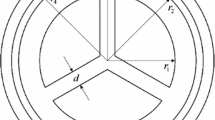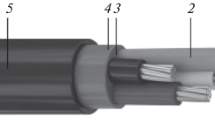Abstract
A complete modeling technique for unshielded power cables is proposed. The focus is on applications where the resonance phenomena take place in electrically long cables and is originated from periodic excitation, such as power converters. The resonance problems caused by switching converters tend to become more common with the advent of wide band gap semiconductors. This paper includes a new experimental protocol specific for unshielded power cable parameter identification in a wide frequency band, from DC up to medium frequencies (tens of MHz), with an impedance analyzer. It also introduces a frequency-domain simulation tool with conversion to the time domain, via the Fourier series. This frequency-domain modeling is straightforward, and its accuracy depends only on the accuracy of the cable parameter identification.


















Similar content being viewed by others
References
Agrawal AK, Lee K, Scott LD et al (1979) Experimental characterization of multiconductor transmission lines in the frequency domain. IEEE Trans EMC 21:28–32
Batura R, Opydo W (2005) Overvoltages caused by switching unloaded cable lines by a vacuum switch. Electr Eng 87(4):181–189. https://doi.org/10.1007/s00202-004-0238-2
Brandão JA, das Neves MG (2011) Basic principles concerning the experimental evaluation of the frequency-dependent parameters of shielded and unshielded three-phase symmetric cables. IEEE Trans Power Deliv 26:556–564
Chu X, Lin F, Yang Z (2014) The analysis of time-varying resonances in the power supply line of high speed trains. In: International power electronics conference
Clavel E, Roudet J, Guichon J et al (2018) A nonmeshing approach for modeling grounding. IEEE Trans EMC 60(3):795–802. https://doi.org/10.1109/TEMC.2017.2743227
Clavel E, Roudet J, Hayashi Feuerharmel A, et al (2019) Benefits of the ground peec modeling approach—example of a residential building struck by lightning. IEEE Trans EMC. pp 1–9. https://doi.org/10.1109/TEMC.2019.2898234
Cristina S, Feliziani M (1989) A finite element technique for multiconductor cable parameters calculation. IEEE Trans Magn 25:2986–2988
Gao Z, Ji R, Zhang X, et al (2016) Finite-element modeling and impedance characteristics analysis of two parallel cables in aircraft power system. In: 2016 IEEE/CSAA international conference on aircraft utility systems (AUS), Beijing
Gentili GG, Salazar-Palma M (1995) The definition and computation of modal characteristic impedance in quasi-TEM coupled transmission lines. IEEE Trans Microw Theory Tech, pp 338–343
Gómez P, Uribe FA (2009) The numerical Laplace transform: an accurate technique for analyzing electromagnetic transients on power system devices. Int J Electr Power Energy Syst 31(2):116–123. https://doi.org/10.1016/j.ijepes.2008.10.006
Gong X, Ferreira JA (2014) Comparison and Reduction of conducted EMI in SiC JFET and Si IGBT-based motor drives. IEEE Trans Power Electron 29(4):1757–1767. https://doi.org/10.1109/TPEL.2013.2271301
Guo JJ, Boggs SA (2011) High frequency signal propagation in solid dielectric tape shielded power cables. IEEE Trans Power Deliv 26(3):1793–1802. https://doi.org/10.1109/TPWRD.2010.2099134
Habib S, Kordi B (2013) Calculation of multiconductor underground cables high-frequency per-unit-length parameters using electromagnetic modal analysis. IEEE Trans Power Deliv 28:276–284
Honarbakhsh B, Asadi S (2017) Analysis of multiconductor transmission lines using the CN-FDTD method. IEEE Trans EMC 59:184–192
Hosoya M (2000) The simplest equivalent circuit of a multi-terminal network. Bull Fac Sci Univ Ryukyus 70:1–10
Idir N, Weens Y, Franchaud JJ (2009) Skin effect and dielectric loss models of power cables. IEEE Trans Dielectr Electr Insul 16(1):147–154. https://doi.org/10.1109/TDEI.2009.4784562
Kerkman RJ, Skibinski DLGL (1997) Interaction of drive modulation and cable parameters on AC motor transients. IEEE Trans Ind Appl 33(3):722–731. https://doi.org/10.1109/28.585863
Keysight Technologies: E4990A Impedance Analyzer—Data Sheet (2018). https://literature.cdn.keysight.com/litweb/pdf/5991-3890EN.pdf?id=2459964. Accessed 11 Jan 2019
Kim JH, Oh D, Kim W (2010) Accurate characterization of broadband multiconductor transmission lines for high-speed digital systems. IEEE Trans Adv Packag 33:857–867
Knockaert J, Peuteman J, Catrysse J et al (2010) A vector impedance meter method to characterize multiconductor transmission-line parameters. IEEE Trans EMC 52:1019–1025
Kruizinga B, Wouters PAAF, Steennis EF (2015) High frequency modeling of a shielded four-core low voltage underground power cable. IEEE Trans Dielectr Electr Insul 22:649–656
Marlier C, Videt A, Idir N (2015) NIF-based frequency-domain modeling method of three-wire shielded energy cables for EMC simulation. IEEE Trans EMC 57(1):145–155. https://doi.org/10.1109/TEMC.2014.2359514
Moreira AF, Lipo TH, Venkataramanan G et al (2002) High-frequency modeling for cable and induction motor overvoltage studies in long cable drivers. IEEE Trans Power Electron 25:1297–1306
Paul C (2008) Analysis of multiconductor transmission lines. IEEE Press, New Jersey
de Paula H, de Andrade DA, Chaves MLR et al (2008) Methodology for cable modeling and simulation for high-frequency phenomena studies in pwm motor drives. IEEE Trans Power Electron 23:744–752
Revol B, Roudet J, Schanen J et al (2011) Emi study of three-phase inverter-fed motor drives. IEEE Trans Ind Appl 47(1):223–231
Scheich R, Roudet J, Bigot S et al (1993) Common mode RFI of a HF power converter: phenomena, its modelling and its measurement. In: EPE’93
Sousounis MC, Shek JKH, Mueller MA (2016) Filter design for cable overvoltage and power loss minimization in a tidal energy system with onshore converters. IEEE Trans Sustain Energy 7:400–408
Stevanović I, Wunsch B, Madonna GL et al (2014) High-frequency behavioral multiconductor cable modeling for emi simulations in power electronics. IEEE Trans Ind Inf 10:1392–1400
Uribe FA, Flores J (2018) Parameter estimation of arbitrary-shape electrical cables through an image processing technique. Electr Eng 100(3):1749–1759. https://doi.org/10.1007/s00202-017-0651-y
Wang L, Avolio G, Deconinck G et al (2014) Estimation of multi-conductor powerline cable parameters for the modelling of transfer characteristics. IET Sci Meas Technol 8:39–45. https://doi.org/10.1049/iet-smt.2012.0123
Wang L, Ho CN, Canales F et al (2010) High-frequency modeling of the long-cable-fed induction motor drive system using TLM approach for predicting overvoltage transients. IEEE Trans Power Electron 25(10):2653–2664. https://doi.org/10.1109/TPEL.2010.2047027
Weens Y, Idir N, Bausière R et al (2006) Modeling and simulation of unshielded and shielded energy cables in frequency and time domains. IEEE Trans Magn 44:1876–1882
Williams DF (1997) Multiconductor transmission line characterization. IEEE Trans Compon Packag Manuf Technol 20:129–132
Wunsch B, Stevanović I (2017) Length-scalable multi-conductor cable modeling for EMI simulations in power electronics. IEEE Trans Power Electron 32:1908–1916
Zhang S, Jiang S, Lu X et al (2014) Resonance issues and damping techniques for grid-connected inverters with long transmission cable. IEEE Trans EMC 29:110–120
Acknowledgements
The authors would like to thank Dr. Mario Leite from IPT (Institute of Technological Research, São Paulo, Brazil) for his help on measurements that contributed to this paper.
Author information
Authors and Affiliations
Corresponding author
Additional information
Publisher's Note
Springer Nature remains neutral with regard to jurisdictional claims in published maps and institutional affiliations.
Appendix
Appendix
The estimation of the stray capacitance between the cable conductors and a concrete plane (floor, walls) can be done using the PEEC technique described in [5, 6]. This method was applied to calculate the capacitance of a wire of radius \(r_0\) and length \(\ell \) parallel to a concrete ground, placed at a distance h above the ground, as shown in Fig. 19. In the figure, \(\sigma _1\) is the complex conductivity of the air and \(\sigma _2\) is the complex conductivity of the concrete. The capacitance between the wire and the concrete surface can be calculated with Eqs. (15) to (18).
As an example, suppose the section of the wire is \(2.5\,\mathrm{mm}^2\), its length \(\ell =1\) m, and it is placed at \(h=1\) m. In this case, the stray capacitance between the wire and the concrete floor (\(\sigma _2=2.5\) mS/m) would be:
Based on this example, the stray capacitances in the impedance measurement set were estimated to be of the order of 10 pF along the document.
Rights and permissions
About this article
Cite this article
Bade, T.G., Roudet, J., Guichon, JM. et al. Frequency-domain modeling of unshielded multiconductor power cables for periodic excitation with new experimental protocol for wide band parameter identification. Electr Eng 101, 333–343 (2019). https://doi.org/10.1007/s00202-019-00780-2
Received:
Accepted:
Published:
Issue Date:
DOI: https://doi.org/10.1007/s00202-019-00780-2





